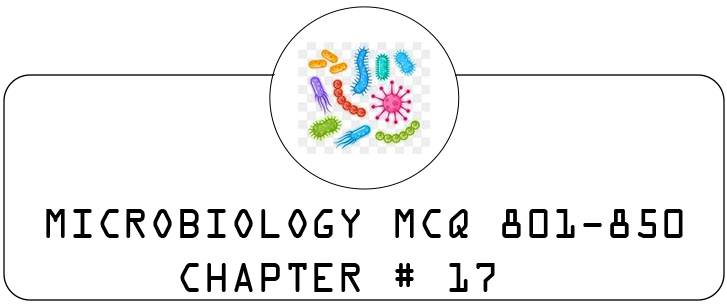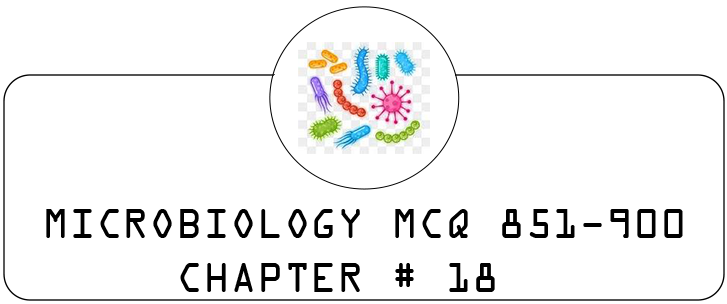751. Rubber catheters are best sterilized by:
A. Formalin vapor
B. Glutaraldehyde
C. Gamma radiation
D. Autoclaving ✅
A. Formalin vapor
B. Glutaraldehyde
C. Gamma radiation
D. Autoclaving ✅
752. Which of the following is highly sensitive to heat?
A. Staphylococcus
B. Pseudomonas
C. Clostridia ✅
D. Treponema
A. Staphylococcus
B. Pseudomonas
C. Clostridia ✅
D. Treponema
753. Soiled dressings are destroyed by:
A. Hot air oven
B. Autoclaving ✅
C. Boiling
D. Incineration
A. Hot air oven
B. Autoclaving ✅
C. Boiling
D. Incineration
754. Spores of which of the following are used as a microbiological test of dry heat efficiency:
A. Toxigenic strains of E. coli
B. Toxigenic strains of Clostridium tetani
C. Non-toxigenic strains of Clostridium tetani ✅
D. Non-toxigenic strains of Proteus
A. Toxigenic strains of E. coli
B. Toxigenic strains of Clostridium tetani
C. Non-toxigenic strains of Clostridium tetani ✅
D. Non-toxigenic strains of Proteus
755. The following is the direct stain for capsule:
A. Fleming’s Nigrosin method
B. Dry India ink film method ✅
C. Welch method
D. Both “A” and “B”
A. Fleming’s Nigrosin method
B. Dry India ink film method ✅
C. Welch method
D. Both “A” and “B”
756. The major mechanism of the lethal effect of UV light on bacteria is attributed to its effect on:
A. Ribosome
B. Lysosome
C. Mesosome
D. DNA ✅
A. Ribosome
B. Lysosome
C. Mesosome
D. DNA ✅
757. Koch’s old tuberculin is preserved in:
A. 70% formalin
B. 50% glycerine
C. 2% phenol ✅
D. Absolute alcohol
A. 70% formalin
B. 50% glycerine
C. 2% phenol ✅
D. Absolute alcohol
758. “Turbidity test” for milk is used to detect its:
A. Pasteurization
B. Sterilization
C. Contamination ✅
D. Lactobacillus contents
A. Pasteurization
B. Sterilization
C. Contamination ✅
D. Lactobacillus contents
759. Microorganisms can be phagocytosed after:
A. Opsonization ✅
B. Hydrolysis
C. Cytolysis
D. Ingestion
A. Opsonization ✅
B. Hydrolysis
C. Cytolysis
D. Ingestion
760. The colors of acid fast and non-acid fast bacteria are respectively:
A. Blue, red
B. Red, blue ✅
C. Red, black
D. Black, purple
A. Blue, red
B. Red, blue ✅
C. Red, black
D. Black, purple
761. In Albert’s staining, the volutin granules are stained _______ against a _______ background:
A. Bluish black, green ✅
B. Green, bluish black
C. Red, blue
D. Black, yellow
A. Bluish black, green ✅
B. Green, bluish black
C. Red, blue
D. Black, yellow
762. Which of the following is NOT a characteristic of viruses?
A. They are prokaryotic
B. They contain genetic material
C. They are acellular ✅
D. They require a host to replicate
A. They are prokaryotic
B. They contain genetic material
C. They are acellular ✅
D. They require a host to replicate
763. Which of the following pathogens is associated with food poisoning from undercooked poultry?
A. E. coli
B. Salmonella ✅
C. Listeria
D. Staphylococcus aureus
A. E. coli
B. Salmonella ✅
C. Listeria
D. Staphylococcus aureus
764. The primary role of phagocytes is to:
A. Produce antibodies
B. Destroy pathogens ✅
C. Induce inflammation
D. Activate T cells
A. Produce antibodies
B. Destroy pathogens ✅
C. Induce inflammation
D. Activate T cells
765. The antibiotic penicillin works by:
A. Inhibiting protein synthesis
B. Disrupting cell wall synthesis ✅
C. Inhibiting nucleic acid synthesis
D. Disrupting metabolic pathways
A. Inhibiting protein synthesis
B. Disrupting cell wall synthesis ✅
C. Inhibiting nucleic acid synthesis
D. Disrupting metabolic pathways
766. Which of the following is the causative agent of syphilis?
A. Treponema pallidum ✅
B. Neisseria gonorrhoeae
C. Chlamydia trachomatis
D. Mycoplasma genitalium
A. Treponema pallidum ✅
B. Neisseria gonorrhoeae
C. Chlamydia trachomatis
D. Mycoplasma genitalium
767. The normal flora of the human gut primarily consists of:
A. Viruses
B. Fungi
C. Bacteria ✅
D. Protozoa
A. Viruses
B. Fungi
C. Bacteria ✅
D. Protozoa
768. The clinical presentation of bacterial meningitis usually includes:
A. Fever
B. Headache
C. Stiff neck ✅
D. All of the above
A. Fever
B. Headache
C. Stiff neck ✅
D. All of the above
769. Which of the following is a common method of diagnosing streptococcal pharyngitis?
A. Throat culture ✅
B. Blood culture
C. Urinalysis
D. Chest X-ray
A. Throat culture ✅
B. Blood culture
C. Urinalysis
D. Chest X-ray
770. The primary component of the influenza virus is:
A. DNA
B. RNA ✅
C. Protein
D. Lipid
A. DNA
B. RNA ✅
C. Protein
D. Lipid
771. The process by which bacteria divide is called:
A. Binary fission ✅
B. Mitosis
C. Budding
D. Conjugation
A. Binary fission ✅
B. Mitosis
C. Budding
D. Conjugation
772. The following organism is known to cause 'walking pneumonia':
A. Mycoplasma pneumoniae ✅
B. Streptococcus pneumoniae
C. Haemophilus influenzae
D. Legionella pneumophila
A. Mycoplasma pneumoniae ✅
B. Streptococcus pneumoniae
C. Haemophilus influenzae
D. Legionella pneumophila
773. The enzyme that breaks down hydrogen peroxide in bacteria is:
A. Catalase ✅
B. Peroxidase
C. Oxidase
D. Superoxide dismutase
A. Catalase ✅
B. Peroxidase
C. Oxidase
D. Superoxide dismutase
774. The bacterial genus that includes pathogens known for causing gastrointestinal disease is:
A. Bacillus
B. Clostridium ✅
C. Streptococcus
D. Staphylococcus
A. Bacillus
B. Clostridium ✅
C. Streptococcus
D. Staphylococcus
775. A common method of preserving bacterial cultures is:
A. Freezing
B. Lyophilization ✅
C. Autoclaving
D. Boiling
A. Freezing
B. Lyophilization ✅
C. Autoclaving
D. Boiling
776. Which of the following bacteria is known for producing a toxin that inhibits protein synthesis?
A. E. coli
B. Staphylococcus aureus ✅
C. Streptococcus pneumoniae
D. Clostridium difficile
A. E. coli
B. Staphylococcus aureus ✅
C. Streptococcus pneumoniae
D. Clostridium difficile
777. The bacterium responsible for causing anthrax is:
A. Bacillus cereus
B. Bacillus anthracis ✅
C. Clostridium botulinum
D. Staphylococcus aureus
A. Bacillus cereus
B. Bacillus anthracis ✅
C. Clostridium botulinum
D. Staphylococcus aureus
778. The primary mode of transmission for HIV is:
A. Airborne
B. Fecal-oral
C. Sexual contact ✅
D. Vector-borne
A. Airborne
B. Fecal-oral
C. Sexual contact ✅
D. Vector-borne
779. Which of the following viruses is known to cause gastroenteritis?
A. Norovirus ✅
B. Influenza virus
C. Hepatitis virus
D. HIV
A. Norovirus ✅
B. Influenza virus
C. Hepatitis virus
D. HIV
780. The bacterium responsible for causing tuberculosis is:
A. Mycobacterium tuberculosis ✅
B. Staphylococcus aureus
C. Streptococcus pneumoniae
D. Escherichia coli
A. Mycobacterium tuberculosis ✅
B. Staphylococcus aureus
C. Streptococcus pneumoniae
D. Escherichia coli
781. The term 'aseptic technique' refers to:
A. Methods to prevent contamination ✅
B. Methods to culture bacteria
C. Methods to sterilize instruments
D. Methods to isolate pathogens
A. Methods to prevent contamination ✅
B. Methods to culture bacteria
C. Methods to sterilize instruments
D. Methods to isolate pathogens
782. Which of the following is a common opportunistic pathogen in immunocompromised patients?
A. Pseudomonas aeruginosa ✅
B. Streptococcus pneumoniae
C. Staphylococcus aureus
D. Neisseria meningitidis
A. Pseudomonas aeruginosa ✅
B. Streptococcus pneumoniae
C. Staphylococcus aureus
D. Neisseria meningitidis
783. The cell wall of Gram-positive bacteria is characterized by:
A. Thin peptidoglycan layer
B. Thick peptidoglycan layer ✅
C. Presence of an outer membrane
D. Presence of lipopolysaccharides
A. Thin peptidoglycan layer
B. Thick peptidoglycan layer ✅
C. Presence of an outer membrane
D. Presence of lipopolysaccharides
784. Which of the following is a common method for sterilizing heat-sensitive materials?
A. Autoclaving
B. Ethylene oxide ✅
C. Boiling
D. Dry heat
A. Autoclaving
B. Ethylene oxide ✅
C. Boiling
D. Dry heat
785. Which of the following techniques is used for identifying bacterial species based on their biochemical properties?
A. Polymerase chain reaction
B. Biochemical tests ✅
C. Gel electrophoresis
D. DNA sequencing
A. Polymerase chain reaction
B. Biochemical tests ✅
C. Gel electrophoresis
D. DNA sequencing
786. The bacterium responsible for causing cholera is:
A. Vibrio cholerae ✅
B. Salmonella typhi
C. Shigella dysenteriae
D. Escherichia coli
A. Vibrio cholerae ✅
B. Salmonella typhi
C. Shigella dysenteriae
D. Escherichia coli
787. The primary function of the immune system is to:
A. Regulate body temperature
B. Protect against pathogens ✅
C. Aid in digestion
D. Control inflammation
A. Regulate body temperature
B. Protect against pathogens ✅
C. Aid in digestion
D. Control inflammation
788. The enzyme responsible for breaking down hydrogen peroxide in bacteria is:
A. Catalase ✅
B. Peroxidase
C. Superoxide dismutase
D. Oxidase
A. Catalase ✅
B. Peroxidase
C. Superoxide dismutase
D. Oxidase
789. Which of the following is a characteristic of Gram-negative bacteria?
A. Thick peptidoglycan layer
B. Presence of an outer membrane ✅
C. Staining blue with Gram stain
D. No lipopolysaccharide in cell wall
A. Thick peptidoglycan layer
B. Presence of an outer membrane ✅
C. Staining blue with Gram stain
D. No lipopolysaccharide in cell wall
790. The most common method of transmission for tuberculosis is:
A. Fecal-oral
B. Airborne ✅
C. Vector-borne
D. Bloodborne
A. Fecal-oral
B. Airborne ✅
C. Vector-borne
D. Bloodborne
791. Which of the following bacteria is known for causing strep throat?
A. Streptococcus pyogenes ✅
B. Streptococcus pneumoniae
C. Staphylococcus aureus
D. Bacillus anthracis
A. Streptococcus pyogenes ✅
B. Streptococcus pneumoniae
C. Staphylococcus aureus
D. Bacillus anthracis
792. The primary component of the bacterial cell membrane is:
A. Phospholipids ✅
B. Proteins
C. Carbohydrates
D. Nucleic acids
A. Phospholipids ✅
B. Proteins
C. Carbohydrates
D. Nucleic acids
793. Which of the following is an example of a vector-borne disease?
A. Tuberculosis
B. Malaria ✅
C. Influenza
D. Measles
A. Tuberculosis
B. Malaria ✅
C. Influenza
D. Measles
794. The bacterium responsible for causing diphtheria is:
A. Corynebacterium diphtheriae ✅
B. Streptococcus pneumoniae
C. Staphylococcus aureus
D. Mycobacterium tuberculosis
A. Corynebacterium diphtheriae ✅
B. Streptococcus pneumoniae
C. Staphylococcus aureus
D. Mycobacterium tuberculosis
795. The presence of a capsule in bacteria serves to:
A. Provide nutrients
B. Aid in motility
C. Protect against phagocytosis ✅
D. Facilitate reproduction
A. Provide nutrients
B. Aid in motility
C. Protect against phagocytosis ✅
D. Facilitate reproduction
796. The antibiotic rifampicin works by:
A. Inhibiting cell wall synthesis
B. Inhibiting protein synthesis
C. Inhibiting nucleic acid synthesis ✅
D. Disrupting metabolic pathways
A. Inhibiting cell wall synthesis
B. Inhibiting protein synthesis
C. Inhibiting nucleic acid synthesis ✅
D. Disrupting metabolic pathways
797. The disease caused by the bacterium Listeria monocytogenes primarily affects:
A. The respiratory system
B. The gastrointestinal tract
C. Pregnant women and newborns ✅
D. The cardiovascular system
A. The respiratory system
B. The gastrointestinal tract
C. Pregnant women and newborns ✅
D. The cardiovascular system
798. Which of the following is a method of microbial control that involves the removal of all viable microorganisms?
A. Disinfection
B. Sterilization ✅
C. Sanitization
D. Antisepsis
A. Disinfection
B. Sterilization ✅
C. Sanitization
D. Antisepsis
799. Which of the following is an opportunistic pathogen that can cause infections in immunocompromised individuals?
A. Mycobacterium tuberculosis
B. Escherichia coli
C. Pseudomonas aeruginosa ✅
D. Streptococcus pneumoniae
A. Mycobacterium tuberculosis
B. Escherichia coli
C. Pseudomonas aeruginosa ✅
D. Streptococcus pneumoniae
800. The bacterium responsible for causing tetanus is:
A. Clostridium tetani ✅
B. Clostridium botulinum
C. Bacillus anthracis
D. Staphylococcus aureus
A. Clostridium tetani ✅
B. Clostridium botulinum
C. Bacillus anthracis
D. Staphylococcus aureus





